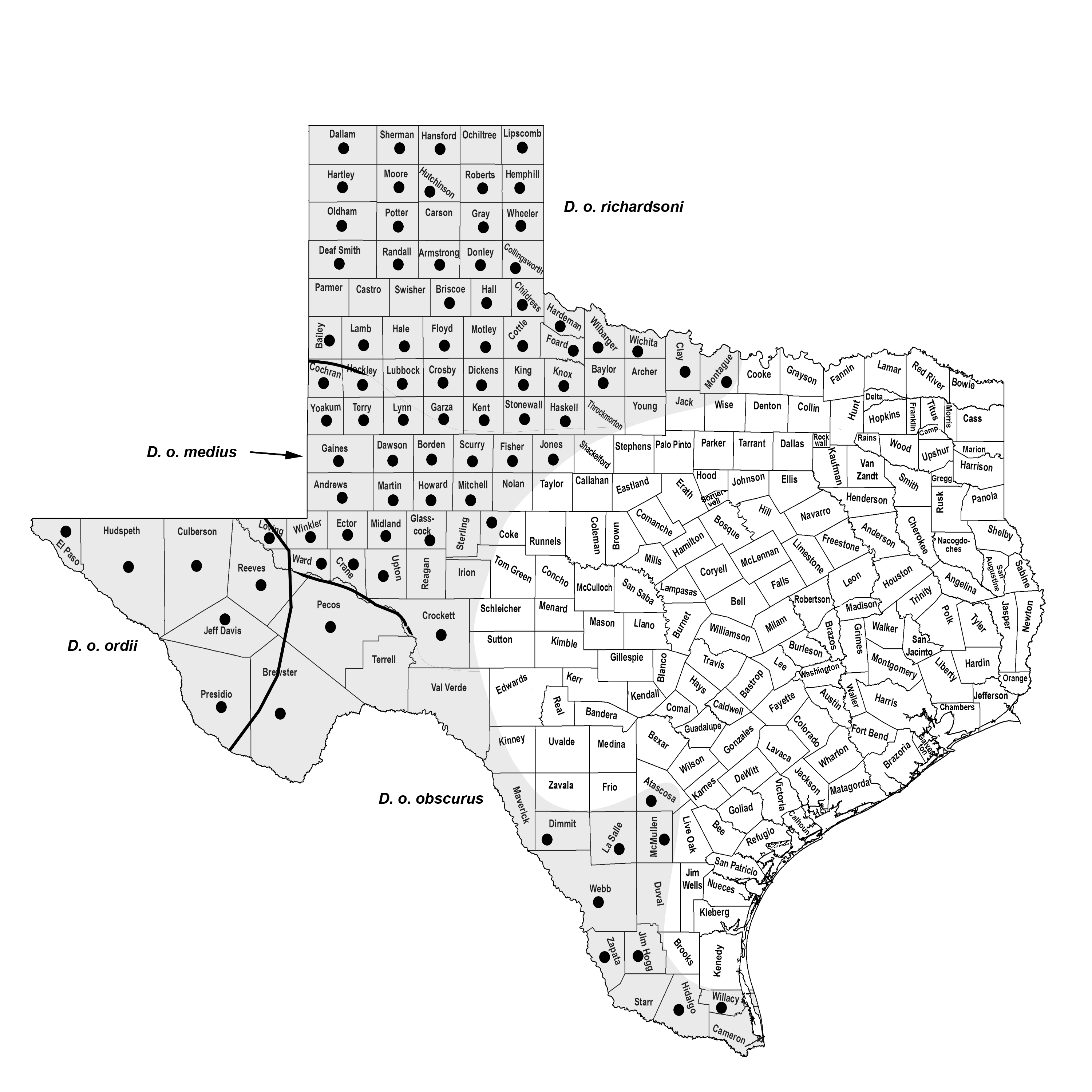ORD'S KANGAROO RAT
Dipodomys ordii Woodhouse 1853
Order Rodentia : Family Heteromyidae
DESCRIPTION. A five-toed kangaroo rat of medium size; tail relatively long, body actually and relatively short; tail seldom white tipped; white patches at base of ears and above eyes usually conspicuous; upperparts pale cinnamon buff, intermixed with blackish; dark markings on face conspicuous. Juveniles similar to adults, but pelage duller and darker. Dental formula: I 1/1, C 0/0, Pm 1/1, M 3/3 × 2 = 20. Averages for external measurements: total length, 253 mm; tail, 159 mm; hind foot, 41 mm. Weight of adults, 60–70 g.

DISTRIBUTION. Known from the western, southwestern, and southern parts of the state.

SUBSPECIES. Dipodomys o. medius from the central Llano Estacado southward east of the Pecos River to Crane, Crockett, and Upton counties; D. o. obscurus in the western, central, and southern parts of the Rio Grande Plains and in the southern Big Bend area; D. o. ordii in most of the Trans-Pecos region; and D. o. richardsoni from the Panhandle and adjacent areas southward at least to Floyd County and east to Montague County.
HABITS. Ord's kangaroo rats, like many others of the genus, are dwellers of wastelands where shifting sands constitute a conspicuous part of the landscape. They are one of the few pioneer mammals that move into shifting dunes and establish themselves with pioneer plants. They rarely occur on hard and gravelly soils. Where they occur in areas with the smaller Merriam's kangaroo rat, Merriam's usually inhabits gravelly or hard soils, and Ord's the sands.
To withstand the extreme climatic conditions in their range, these kangaroo rats dig deep burrows into the sand; when plugged from the inside, the burrows permit the occupants to spend the daylight hours in comfort and to avoid the hot, desiccating sun or the cold, wintery wind. They become active again at night, leaving their dens after sundown, and go abroad in their quest for food even in the dead of winter when snow is on the ground. It appears that they do not hibernate.
Their food consists primarily of the seeds of various desert plants, which they gather and place in their cheek pouches for transport to the burrow to be consumed at leisure. Mesquite, sandbur, tumbleweed, Russian thistle, sunflowers, and countless desert annuals provide them with a wide range of choice. Like many other desert animals, they can produce their needed water physiologically from nearly dry seeds. So averse and unaccustomed to water are they that they cannot swim.
In a 1975 study of dietary overlap between D. merriami and D. ordii in the Guadalupe Mountains, Peggy O'Connell (Texas Tech University) found both generally to be opportunistic granivores, with merriami eating more insects and green vegetation than does ordii. Food consumed in fairly large proportions by one species was usually of minor importance in the diet of the other, thus explaining how the two species avoid competition.
In a 2-year study conducted in the Texas Panhandle (Hemphill County) during the early 1960s, Jack Inglis found pregnant females of D. ordii from August through February. Young individuals first appeared in his traps in November. Litter size, based on embryo counts, averaged slightly fewer than three, with extremes of two and four. Rate of reproduction was associated with precipitation, food supply, and population densities of kangaroo rats and other rodents. After a prolonged drought period when the food supply declined, few females became sexually active and few young were born. After a favorable growing season for food plants, most females in the population became pregnant within the first 2 months of the breeding season, and most of them produced two litters; young females born early in the season produced litters themselves before the season ended. The gestation period is about 30 days. The young are born in underground nests and remain there for nearly 1 month. They appear aboveground when they are about three-fourths grown and weigh 40–50 g.
Because of the nature of their habits, they seldom pose a serious conflict with humans. In sandy lands near San Antonio, however, they have been reported to gather and consume the seeds of watermelons and other row crops.
POPULATION STATUS. Common. Ord's kangaroo rat is common throughout its range in Texas.
CONSERVATION STATUS. The IUCN lists Ord's kangaroo rat as a species of least concern, and it does not appear on the federal or state lists of concerned species. It does not face any major threats.
From The Mammals of Texas, Seventh Edition by David J. Schmidly and Robert D. Bradley, copyright © 1994, 2004, 2016. Courtesy of the University of Texas Press.
Natural Science Research Laboratory
-
Address
Museum of Texas Tech University, 3301 4th street, Lubbock, TX 79409 -
Phone
806.742.2486 -
Email
nsrl.museum@ttu.edu

